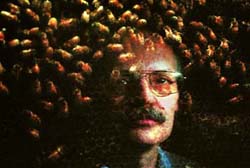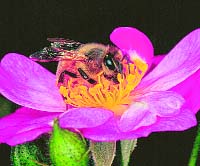________________________The University of Montana President's Report 1999________________________ |
||||||
 |
||||||
Bromenshenk, an adjunct research professor in biological sciences, and chemistry Associate Professor Garon Smith are using honeybees as "flying dust mops" to detect hazardous or undesirable pollutants. To that end, he and his colleagues have developed electronic sensors that can be placed inside a hive to: count the number of bees entering and leaving, identify solid contaminants and sample air in the hive for traces of harmful gases.
He is collaborating with public and private agencies to develop microchips — tiny enough to be glued to the backs of bees — that will allow researchers to pinpoint where contaminants come from and when they arrive in the hive.
While that research continues, one of the collaborating agencies, the Defense Advanced Research Projects Agency, wants the researchers to push the use of bees as biomonitors even further by trying to influence where bees go. So Bromenshenk and several students are experimenting to see whether bees can be conditioned to find a particular food source and follow it as it is gradually moved farther from the hive. Their goal is to get bees to disperse and find specific targets.
|
||||||
________________________The Discovery Continues________________________ |
||||||
| Images: Top, Professor Jerry Bromenshenk and bees. (Michael Gallacher) Second from top, honeybee with yellow pollen baskets flying in rabbitbrush; third, honeybee and scilla siberia; bottom, honeybee and rose. (Gail Bromenshenk) | ||||||




